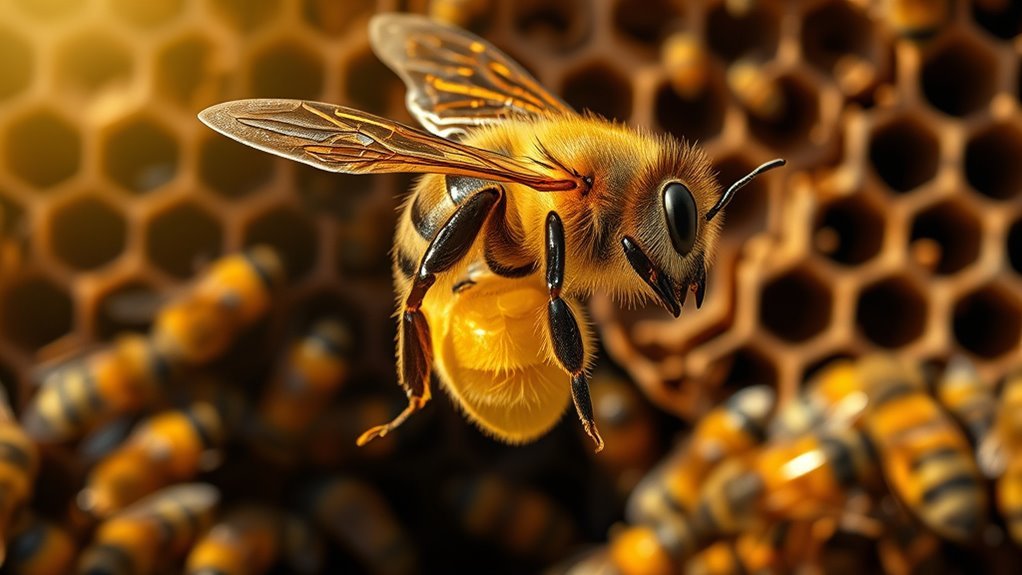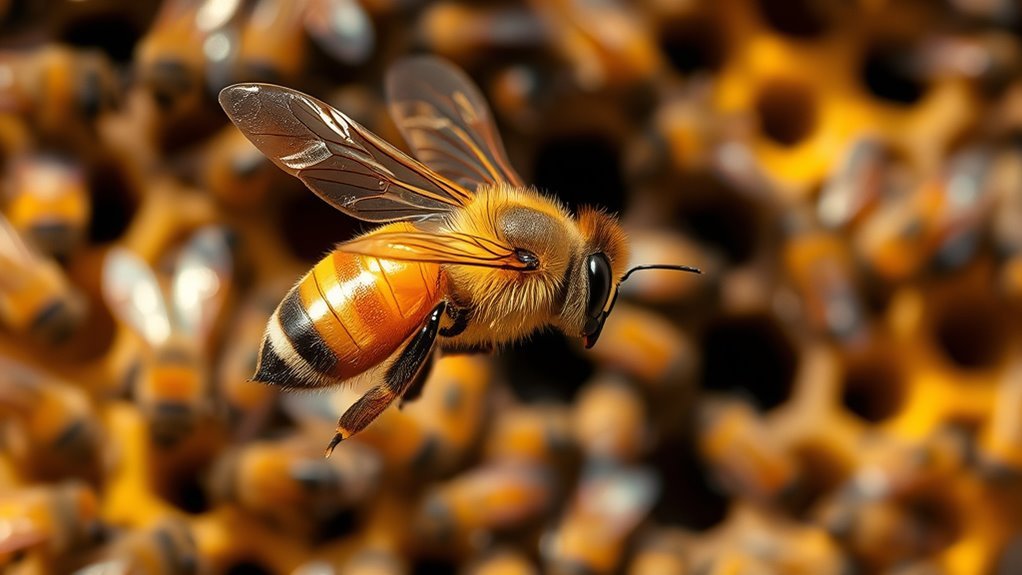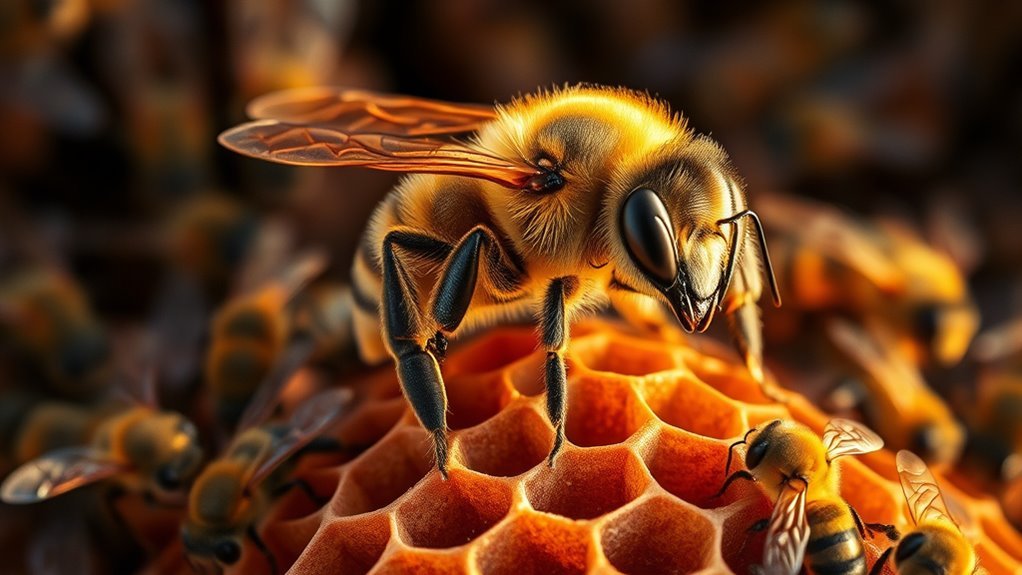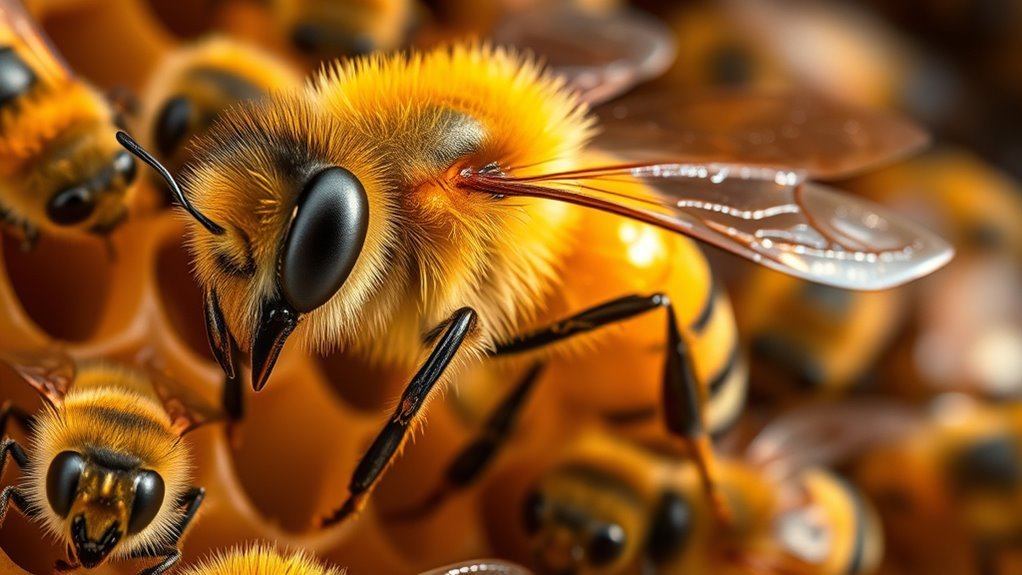Drone honey bees play a critical role in the hive by mating with queens, which guarantees genetic diversity and strengthens the colony’s resilience. They develop from unfertilized eggs and do not gather nectar or pollen. Relying on worker bees for sustenance, drones also influence hive dynamics and resource allocation. As summer ends, they are expelled to prioritize resources for worker bees. Understanding these aspects reveals how essential drones are to a healthy hive ecosystem.
The Lifecycle of Drone Honey Bees

The lifecycle of drone honey bees is a fascinating process that underscores their vital role within the hive. Drones, developed from unfertilized eggs, undergo several stages: egg, larva, pupa, and adult. Their behavior is distinct, primarily focused on mating and contributing to hive dynamics. As drones emerge, they exhibit unique characteristics, such as larger bodies and non-stinging capabilities, which reflect their specialized purpose. While they don’t gather nectar or pollen, their presence is essential for maintaining a balanced hive environment. During peak seasons, drone populations swell, influencing the hive’s social structure and resource allocation. Understanding drone behavior helps you appreciate their significant yet often overlooked contribution to the overall health and functionality of the colony.
The Role of Drones in Reproduction

While drones may seem like mere bystanders in the hive, their primary function revolves around reproduction, making them essential for the colony’s survival. These male bees have a short drone lifespan, often only a few months, but their mating behavior is critical during the queen’s nuptial flights.
Consider the following key points:
- Drones don’t gather nectar or pollen; their sole focus is to mate with a queen.
- Successful mating occurs in flight, where multiple drones compete, ensuring genetic diversity.
- After mating, drones typically die, serving the colony’s reproductive needs at the cost of their own lives.
Ultimately, the role of drones highlights nature’s intricate balance between individual sacrifice and the collective benefit of the hive.
Drones and Genetic Diversity

Although drones primarily exist for mating, their role extends far beyond mere reproduction; they are essential for maintaining the genetic diversity of the hive. By mating with queens from various colonies, drones introduce genetic variability that bolsters the overall health and resilience of the population. This genetic mixing provides evolutionary advantages, allowing the hive to adapt to changing environmental conditions and resist diseases. When you consider that a diverse gene pool enhances the survival chances of the colony, you can appreciate the intricate balance drones maintain. Their seemingly singular function in reproduction transforms into a profound contribution to the hive’s long-term viability, making every drone’s genetic lineage significant for future generations.
The Interaction Between Drones and Worker Bees
In the hive, drones play a vital role primarily centered around mating, which directly influences the genetic diversity of the colony. Meanwhile, worker bees undertake various responsibilities, including foraging, nursing, and hive maintenance, creating a complex social structure. Understanding these interactions illuminates how both drones and worker bees contribute to the hive’s overall health and reproductive success.
Mating Role of Drones
As drones mature within the hive, their primary role becomes increasingly evident: to mate with a queen during her nuptial flights. This mating process is essential for maintaining hive dynamics and ensuring genetic diversity. Understanding drone behavior sheds light on their interactions within the colony.
Key aspects of their mating role include:
- Selection Pressure: Only the fittest drones typically mate, ensuring strong genetic traits are passed on.
- Spatial Awareness: Drones navigate and converge towards mating areas, showcasing their keen awareness of environmental cues.
- Competition: Drones often engage in competitive flights, which helps to refine their abilities and select the best mates for the queen.
Through these behaviors, drones greatly influence the overall health and resilience of the hive.
Worker Bee Responsibilities
While worker bees mainly handle the day-to-day tasks within the hive, their interactions with drones are crucial for the colony’s overall success. Worker bees communicate effectively, sharing essential information about resource availability and hive needs. This communication guarantees efficient hive resource management, allowing the colony to thrive. Drones, though less active in daily tasks, rely on worker bees for sustenance and support. They benefit from the worker bees’ foraging efforts, which provide necessary nutrition. The relationship between worker bees and drones exemplifies a balance; while worker bees focus on nurturing the hive, they also play a significant role in preparing drones for mating flights. This symbiotic dynamic underscores the importance of cooperation for the hive’s survival and reproductive success.
Seasonal Changes and the Fate of Drones
Although drones play an essential role in the reproductive cycle of honey bees, their fate shifts dramatically with the changing seasons. As summer fades, you’ll notice significant seasonal behaviors affecting drone survival. In the fall, the hive prepares for winter, leading to the expulsion of drones. Their reproductive function becomes less critical, and survival rates plummet.
Key factors influencing their fate include:
- Resource allocation: The colony prioritizes worker bees for food and warmth.
- Mating season conclusion: Drones are no longer needed once the queen has mated.
- Colony health: A healthy hive can afford to discard non-contributing members.
Understanding these dynamics illustrates the harsh realities of drone existence in the hive.
The Importance of Drones to Colony Health
Drones play an important role in maintaining colony health by facilitating mating with queen bees, which directly influences genetic diversity. This genetic variation is essential for resilience against diseases and environmental changes, enhancing the overall stability of the colony. Additionally, a balanced population of drones helps regulate hive dynamics, ensuring that the colony remains robust and productive.
Mating With Queen Bees
The mating process between drones and queen bees is fundamental for maintaining the genetic diversity and overall health of a hive. During this significant phase, drones exhibit specific mating behaviors that facilitate successful queen selection. Here’s why this process matters:
- Genetic Diversity: Mating with multiple drones guarantees varied genetic material, enhancing resilience against diseases.
- Colony Strength: Healthy, well-mated queens produce more vigorous offspring, directly impacting colony productivity.
- Survival of the Fittest: Drones that successfully mate with queens demonstrate advantageous traits, promoting natural selection within the hive.
Understanding these dynamics is essential for beekeepers and enthusiasts alike, as the health of a hive hinges on the quality of its mating practices. Essentially, drones play a pivotal role in guaranteeing a thriving colony.
Genetic Diversity Contribution
While many may overlook the significance of drones in a bee colony, their contribution to genetic diversity is essential for overall colony health. Drones facilitate genetic variation by mating with queen bees, introducing a range of traits that enhance resilience against diseases and environmental stressors. This genetic mixing fosters evolutionary advantages, enabling colonies to adapt more effectively to changes. By ensuring diverse gene pools, drones help mitigate the risks associated with inbreeding, which can lead to weakened colonies. The presence of varied genetic traits can also lead to more robust foraging behaviors and improved hive productivity. Ultimately, the genetic diversity brought by drones is a cornerstone of colony survival, reinforcing the importance of their role in maintaining a thriving bee community.
Hive Population Balance
Genetic diversity plays a pivotal role in the stability of a bee colony, but it’s not the only aspect of health that drones influence. Drones are essential for maintaining hive stability and balancing population dynamics. Their presence guarantees genetic interchange, which in turn supports robust hive health. Here’s how they contribute:
- Mating with queens: Drones mate with queens from various colonies, enhancing genetic diversity.
- Population resilience: A stable drone population helps buffer against environmental stresses and diseases.
- Resource allocation: Drones influence foraging behavior, optimizing resource use within the hive.
Frequently Asked Questions
How Long Do Drone Honey Bees Live?
When it comes to drone bee lifespan, you’ve got to contemplate their short existence. Typically, they live around 8 weeks, playing a critical role in hive dynamics, yet ultimately facing a swift end after mating.
Do Drone Bees Have Stingers?
Drone bees don’t have stingers, which affects hive dynamics. Their primary function revolves around reproduction, mating with a queen. Lacking stingers allows them to focus solely on their role without the distraction of defense.
What Do Drones Eat in the Hive?
Like a passenger enjoying a free meal on a long flight, drones consume a drone diet of pollen and honey, essential for their energy. Their contributions to the hive, however, focus primarily on reproduction, not sustenance.
Can Drones Fly Alone Outside the Hive?
Yes, drones can fly alone outside the hive. Their navigation relies on visual cues and pheromones, allowing them to interact with the hive and locate mates, which is essential for their reproductive role in the colony.
How Many Drones Are Typically in a Hive?
Imagine a bustling city; a hive’s drone population can vary from 100 to 300. This small group influences hive dynamics, ensuring reproduction and genetic diversity, just like citizens shaping a community’s future through their existence.

